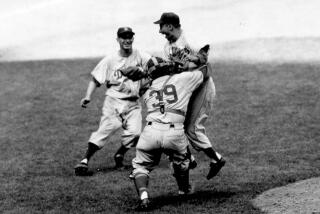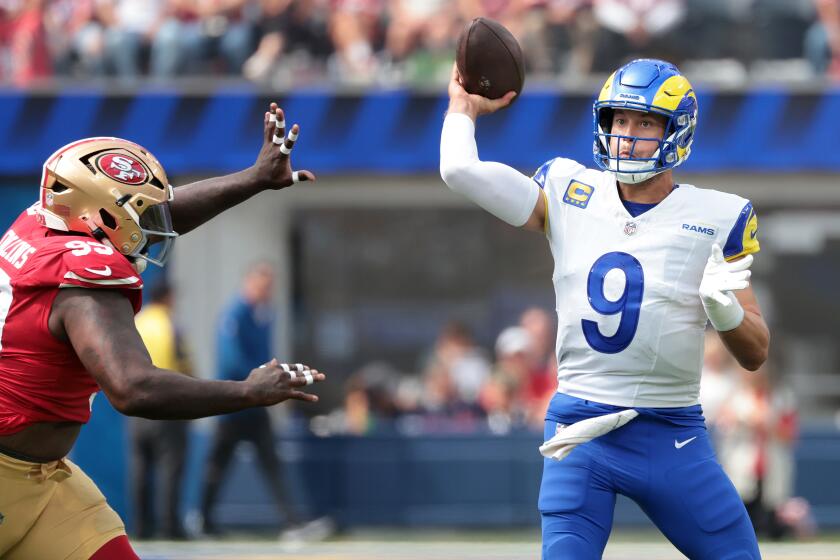The 1969 World Series champion Mets remain Amazin’ 50 years later
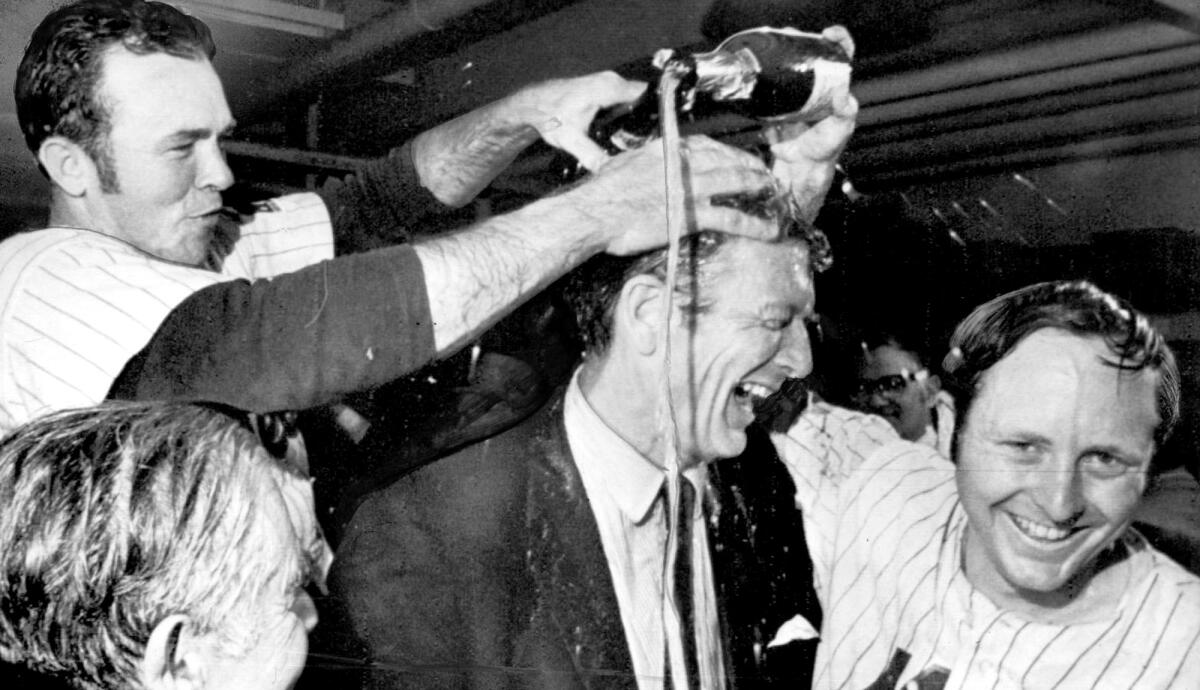
- Share via
If an assist could be awarded for one of the greatest catches in World Series history — Ron Swoboda’s sprint-and-sprawl into the right-center field gap for the New York Mets in 1969 — it would go to Rod Gaspar, a reserve outfielder on that team.
“Here’s the thing about Swoboda — he wasn’t a very good defensive outfielder,” Gaspar, 72, said in the living room of his Mission Viejo home.
“A number of years ago, he and I were waiting for a cab to take us to a card show in New York. He said, ‘Rodney, you know what got me going that year with my defense? It ticked me off when you would come in and replace me in the outfield.’ He worked his tail off that year with our third-base coach, Eddie Yost, who hit him hundreds and hundreds of balls. He made himself into a good outfielder.”
Five decades have done little to dull Gaspar’s memories of one of baseball’s most improbable seasons, when an expansion team that had finished no higher than ninth place in the 10-team National League and lost at least 100 games in five of its first seven seasons pitched and clutch-hit its way to a championship.
Gaspar was one of 15 players from the 1969 team honored at Citi Field on June 29 during a 50th anniversary celebration of the Mets’ first title.
Players rode in the backseats of 1969 Mustang convertibles in a parade down Seaver Way, a street outside the stadium renamed for former Mets ace and Hall-of-Famer Tom Seaver, who went 25-7 with a 2.21 ERA in 1969. Mayor Bill de Blasio presented players with keys to the city.
Seaver, diagnosed with dementia this year, did not attend, but his wife, daughters and grandsons did. Jerry Koosman, Cleon Jones, Ed Kranepool, Jerry Grote, Bud Harrelson and Swoboda were among the players on hand. Gaspar had 15 family members there, including his wife, Sheridan, and several kids and grandchildren.
“I wasn’t planning on going at first,” said Gaspar, a former Lakewood High School and Long Beach State star who was a 23-year-old rookie in 1969. “But I knew it was a once-in-a-lifetime thing.”
So, it seems, was the 1969 team known by the nicknames Amazin’ Mets and Miracle Mets.
Few expected them to contend in the first year of divisional play, but Grote, a standout defensive catcher, had an inkling they would.
“He told Seaver in spring training that we can win this thing,” Gaspar said. “He had tremendous confidence in our pitching staff.”
That faith was warranted. Seaver, then 24, used his vintage drop-and-drive delivery to throw 18 complete games, five shutouts — he came within two outs of a perfect game against the Chicago Cubs on July 9 — and strike out 208 en route to his first of three Cy Young awards.
Koosman, a 26-year-old left-hander, went 17-9 with a 2.28 ERA, 16 complete games and six shutouts. Gary Gentry, a 22-year-old right-hander, went 13-12 with a 3.43 ERA.
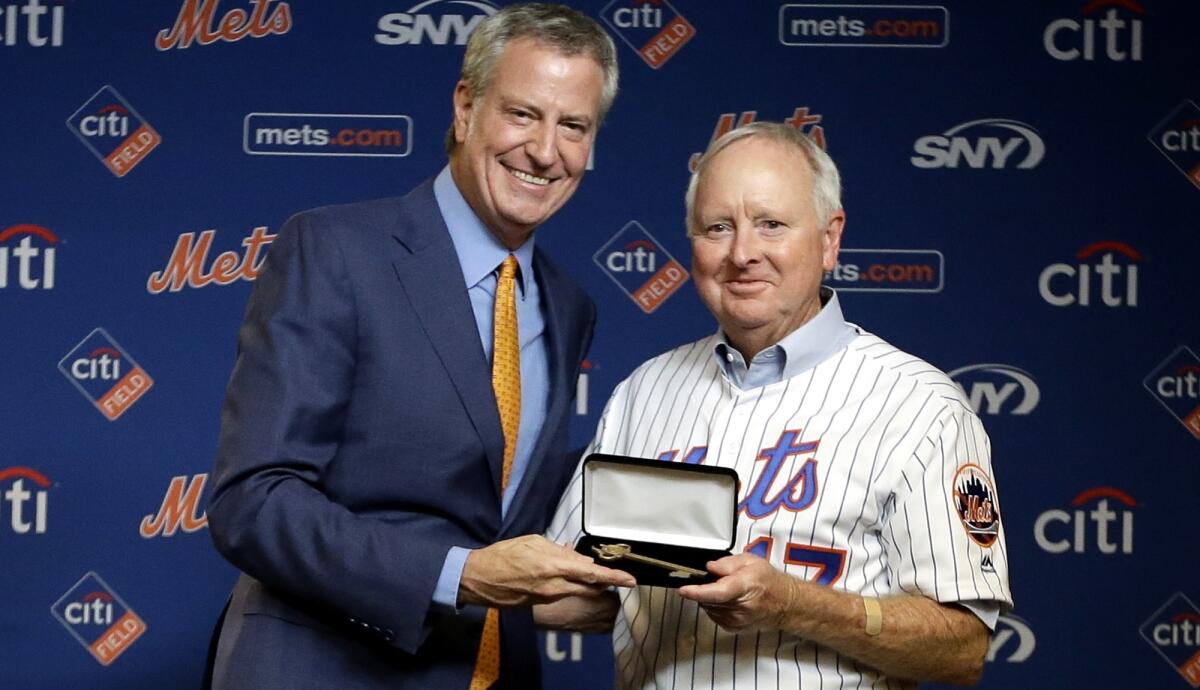
Ron Taylor (9-4, 2.72 ERA in 59 games) and left-hander Tug McGraw (9-3, 2.24 ERA in 42 games) anchored a bullpen that included a flame-throwing but erratic 22-year-old swingman named Nolan Ryan.
“The rotation was so good that Ryan was hardly used,” Gaspar said. “Our first three guys were lights out.”
The offense was not as electric. The Mets hit .242 with a .662 on-base-plus-slugging percentage (only one World Series winner, the 1988 Dodgers, had a lower OPS in the last 50 years). They hit 109 homers and scored 632 runs.
But they hit .263 with a .722 OPS with runners in scoring position and were 41-23 in one-run games.
Former Dodgers great Gil Hodges was the manager, and the Mets played sound defense and executed the fundamentals.
“When we got two runs,” said Gaspar, a reserve outfielder who hit .228 in 118 games, “the pitchers were happy.”
There was little indication in the first two months of what was to come. The Mets were 18-23 and nine games back on May 27 before reeling off 11 wins in a row.
Sign up for our free sports newsletter >>
A three-game sweep by the Astros in Houston dropped New York 10 games back Aug. 13. The Mets returned home and won 14 of 16 games, starting with back-to-back doubleheader sweeps of San Diego on Aug. 16-17.
The Mets went 38-11 over their final 49 games to finish 100-62. The Cubs collapsed, and New York won the division by eight games.
“I’m not sure what triggered it,” Gaspar said of the finishing flourish. “But you know how momentum is. You get a break here and there, and off you go.”
The Mets believed they were a team of destiny, and who could blame them?
San Francisco ace Juan Marichal threw 13 shutout innings in Shea Stadium on Aug. 19. The Mets won 1-0 on Tommy Agee’s homer off Marichal with one out in the 14th.
The Mets swept a Sept. 12 doubleheader at Pittsburgh, both by 1-0 scores in which their pitchers — Koosman and Don Cardwell — knocked in the only runs.
“When does that ever happen?” Gaspar said.
Three days later, Cardinals ace Steve Carlton struck out 19 Mets in Busch Stadium, but Swoboda hit a pair of two-run homers in a 4-3 win.
“There were so many games we won that we wouldn’t have won before,” said Gaspar, who moved to Mission Viejo after his playing career ended in 1976.
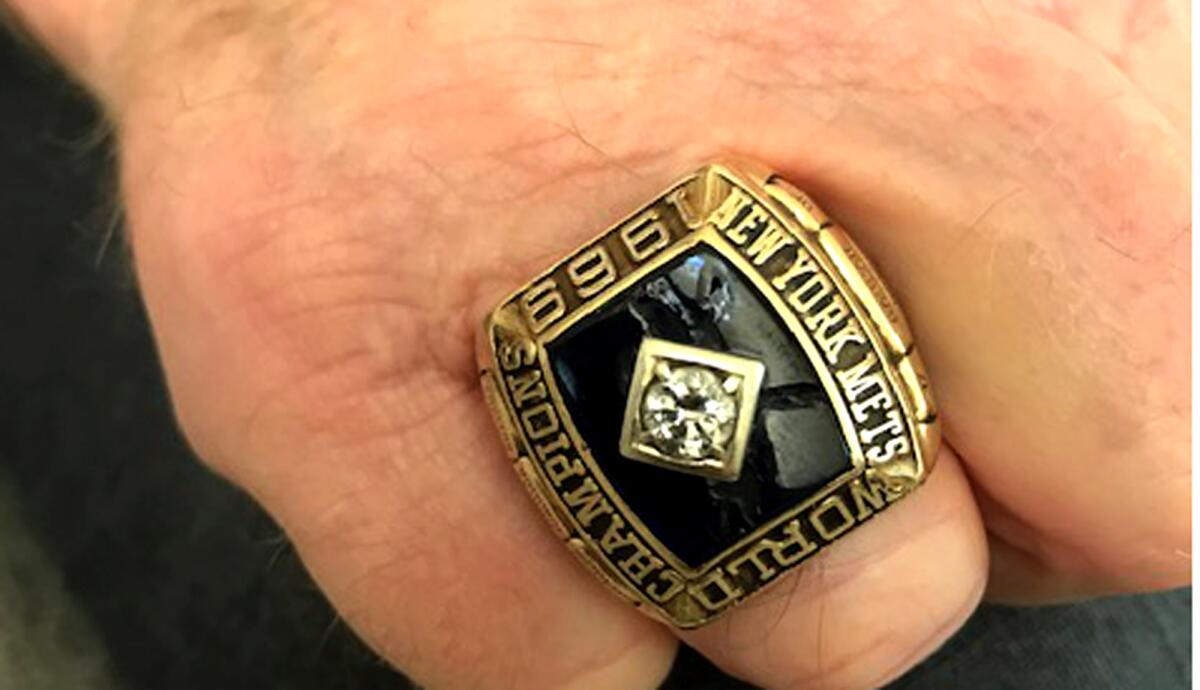
The Mets offense broke out with 27 runs in a three-game sweep of Atlanta in the first NL Championship Series. Pitching and defense took over in a five-game World Series win over Baltimore in which no game lasted more than 2 hours 33 minutes.
The teams split the first two games in Baltimore, the Orioles beating Seaver 4-1 in Game 1 and Koosman throwing 8 2/3 innings of two-hit ball in a 2-1 Mets win in Game 2.
Agee, the Mets center fielder, saved five runs in Game 3 with a snow-cone catch of Elrod Hendricks’ fourth-inning drive to the left-center-field wall with two on in the fourth inning and a diving catch of Paul Blair’s seventh-inning flare to right-center with the bases loaded to end the seventh. The Mets won 5-0.
Swoboda’s catch highlighted a 2-1 Game 4 win. With runners on first and third and one out in the ninth, Brooks Robinson lined a ball to right-center. Swoboda, after a quick burst of speed, hurled himself into the air and made a full-extension diving catch, the ball nestling in the tip of his glove with his body parallel to the ground.
Frank Robinson tagged and scored the tying run, but the catch prevented a bigger inning. Gaspar then scored the winning run on a 10th-inning error. Koosman threw a complete game the next day in a series-clinching 5-3 Game 5 win as fans swarmed the Shea Stadium field.
“He was like Superman,” Gaspar said of Swoboda’s Game 4 acrobatics. “If that ball was an inch farther to his right, he wouldn’t have caught it. That’s how far he extended. It’s the greatest play I’ve ever seen.”
Did Gaspar feel like he had a hand in it?
“Well, maybe,” he said, “because later in the season, Gil wouldn’t put me in for him.”
More to Read
Go beyond the scoreboard
Get the latest on L.A.'s teams in the daily Sports Report newsletter.
You may occasionally receive promotional content from the Los Angeles Times.

